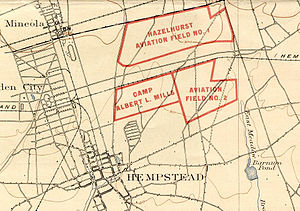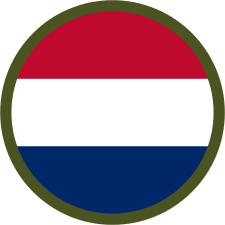
The American Expeditionary Forces (AEF) was a formation of the United States Armed Forces on the Western Front during World War I, composed mostly of units from the U.S. Army. The AEF was established on July 5, 1917, in France under the command of then-Major General John J. Pershing. It fought alongside French Army, British Army, Canadian Army, British Indian Army, New Zealand Army and Australian Army units against the Imperial German Army. A small number of AEF troops also fought alongside Italian Army units in 1918 against the Austro-Hungarian Army. The AEF helped the French Army on the Western Front during the Aisne Offensive in the summer of 1918, and fought its major actions in the Battle of Saint-Mihiel and the Meuse-Argonne Offensive in the latter part of 1918.

Camp Upton was a port of embarkation of the United States Army during World War I. During World War II, it was used as an Army induction center, an internment camp for enemy aliens, and a hospital. It was located in Yaphank, New York, in Suffolk County on Long Island, on the present-day location of Brookhaven National Laboratory.

Roosevelt Field is a former airport, located in Westbury, Long Island, New York. Originally called the Hempstead Plains Aerodrome, or sometimes Hempstead Plains field or the Garden City Aerodrome, it was a training field for the Air Service, United States Army during World War I.

Mitchel Air Force Base, also known as Mitchel Field, was a United States Air Force base located on the Hempstead Plains of Long Island, New York, United States. Established in 1918 as Hazelhurst Aviation Field #2, the facility was renamed later that year as Mitchel Field in honor of former New York City Mayor John Purroy Mitchel, who was killed while training for the Air Service in Louisiana.

The San Francisco Port of Embarkation (SFPOE) was a United States Army command responsible for movement of supplies and troops to and from the Pacific during World War II with extensive facilities in the San Francisco area. SFPOE was established 6 May 1932 and disestablished 1 October 1955. It was originally composed of the long term Pacific terminal at Fort Mason that had been the home port and terminal for the Pacific Army Transport Service ships. That facility was far too limited to serve the requirements of a full port of embarkation. In 1940 the port began expansion to include Army owned and leased facilities throughout the San Francisco Bay area and for a time sub ports at Seattle and Los Angeles. Those eventually became separate commands as the Seattle Port of Embarkation and Los Angeles Port of Embarkation.

The Boston Port of Embarkation (BPOE) was a United States Army command responsible for the movement of troops and supplies from the United States to overseas commands. In World War I it was a sub-port of the New York Port of Embarkation. During World War II it became an independent Port of Embarkation with the second greatest number of passengers embarked and third greatest tonnage of cargo embarked by east coast Ports of Embarkation. In passengers it was exceeded on the east coast only by New York and in cargo only by New York and the Hampton Roads Port of Embarkation. Within three months after entry of the United States into World War II Boston was being established as a sub-port of New York. With establishment of the United States Army Transportation Corps in March 1942 the Boston sub-port became the independent Boston Port of Embarkation.

The New York Port of Embarkation (NYPOE) was a United States Army command responsible for the movement of troops and supplies from the United States to overseas commands. The command had facilities in New York and New Jersey, roughly covering the extent of today's Port of New York and New Jersey, as well as ports in other cities as sub-ports under its direct command. During World War I, when it was originally known as the Hoboken Port of Embarkation with headquarters in seized Hamburg America Line facilities in Hoboken, New Jersey, the Quartermaster Corps had responsibility. The sub-ports were at Boston, Baltimore, Philadelphia and the Canadian ports of Halifax, Montreal and St. Johns. The World War I port of embarkation was disestablished, seized and requisitioned facilities returned or sold and operations consolidated at the new army terminal in Brooklyn. Between the wars reduced operations continued the core concepts of a port of embarkation and as the home port of Atlantic army ships. With war in Europe the army revived the formal New York Port of Embarkation command with the New York port, the only Atlantic port of embarkation, taking a lead in developing concepts for operations.

The 107th Fighter Squadron is a unit of the Michigan Air National Guard 127th Wing. It is assigned to Selfridge Air National Guard Base, Michigan and is equipped with the Fairchild Republic A-10 Thunderbolt II aircraft.

The 109th Airlift Squadron is a unit of the Minnesota Air National Guard 133d Airlift Wing located at Minneapolis–Saint Paul Joint Air Reserve Station, Minnesota. The squadron is equipped with the C-130H Hercules.
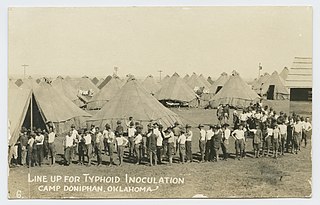
Camp Doniphan was a military base adjacent to Fort Sill, just outside Lawton, in Comanche County, Oklahoma, that was activated for use in World War I for artillery training. The post was closed in 1918 and incorporated into Fort Sill.
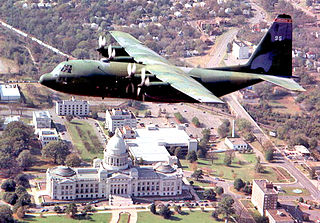
The 154th Training Squadron is a unit of the Arkansas Air National Guard 189th Airlift Wing. It is assigned to Little Rock Air Force Base, Arkansas and is equipped with the C-130H Hercules aircraft.

The 911th Air Refueling Squadron is part of the 305th Operations Group, and is stationed at Seymour Johnson Air Force Base, North Carolina. The squadron was the Air Force's first active duty squadron under the command of a reserve wing. In October 2016, the 911th, formerly geographically separated from the 6th Air Mobility Wing at MacDill Air Force Base, Florida and operated as the active duty associate to the 916th Air Refueling Wing, became the first "I-Wing" or Integrated Wing. In July 2020, it was reassigned to the 305th Operations Group at the McGuire AFB entity of Joint Base McGuire–Dix–Lakehurst, New Jersey.
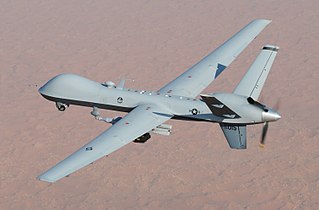
The 50th Attack Squadron is a squadron of the United States Air Force, stationed at Shaw Air Force Base, South Carolina, where it operates the General Atomics MQ-9 Reaper unmanned aerial vehicle. It is assigned to the 25th Attack Group, also at Shaw, and is a component of the 432d Wing, located at Creech Air Force Base, Nevada.
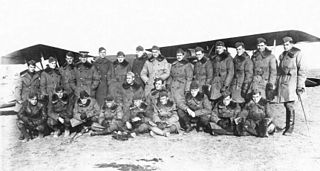
The 139th Aero Squadron was a United States Army Air Service unit that fought on the Western Front during World War I.

Clinton Road was a station stop located on the Garden City–Mitchel Field Secondary branch of the Long Island Rail Road in the Village of Garden City in Nassau County, New York, United States. The historic station house is now used as a fire station.
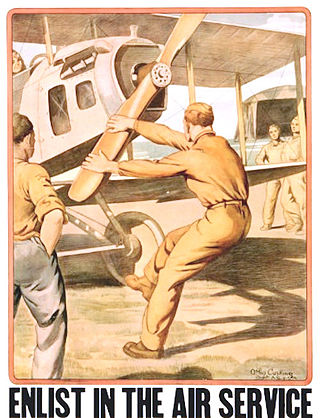
With the purchase of its first airplane, built and successfully flown by Orville and Wilbur Wright, in 1909 the United States Army began the training of flight personnel. This article describes the training provided in those early years, though World War I, and the immediate years after the war until the establishment of the United States Army Air Corps Flight Training Center in San Antonio, Texas during 1926.

Call Field is a former World War I military airfield, located 4.6 miles (7.4 km) southwest of Wichita Falls, Texas. It operated as a training field for the United States Army Air Service between 1917 until 1919. The airfield was one of thirty-two Air Service training camps established in 1918 after the United States entry into World War I.

The 258th Aero Squadron was a United States Army Air Service unit that fought on the Western Front during World War I.

Railway operations were originally established by the United States Army to provide support to France and Great Britain after the United States entered World War I. The Army organized and deployed different types of railway regiments and battalions. As operations progressed, the railway units were used to support the American Expeditionary Forces as well. U.S. rail regiments moved both troops and supplies for the AEF and for the allies from the seaports to the front.

The 27th Construction Company was a United States Army unit that served during World War I. Construction companies were originally created to fulfill the labor requirements created in two agreements between the United States and the United Kingdom, the 5 December agreement and the Rothermere-Foulois agreement. Each company was organized into one of three roles: bricklaying, carpeting, and general laborers. By the end of the war, over 6,000 men had enlisted across 39 construction companies.

